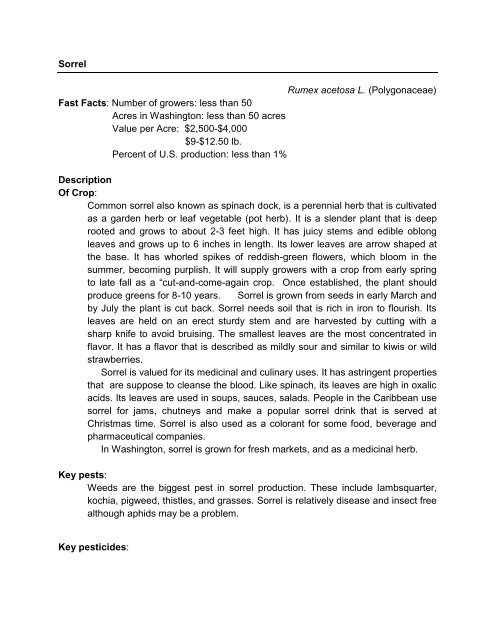Sorrel Rumex acetosa L. (Polygonaceae) Fast Facts: Number of ...
Sorrel Rumex acetosa L. (Polygonaceae) Fast Facts: Number of ...
Sorrel Rumex acetosa L. (Polygonaceae) Fast Facts: Number of ...
You also want an ePaper? Increase the reach of your titles
YUMPU automatically turns print PDFs into web optimized ePapers that Google loves.
<strong>Sorrel</strong><br />
<strong>Rumex</strong> <strong>acetosa</strong> L. (<strong>Polygonaceae</strong>)<br />
<strong>Fast</strong> <strong>Facts</strong>: <strong>Number</strong> <strong>of</strong> growers: less than 50<br />
Acres in Washington: less than 50 acres<br />
Value per Acre: $2,500-$4,000<br />
$9-$12.50 lb.<br />
Percent <strong>of</strong> U.S. production: less than 1%<br />
Description<br />
Of Crop:<br />
Common sorrel also known as spinach dock, is a perennial herb that is cultivated<br />
as a garden herb or leaf vegetable (pot herb). It is a slender plant that is deep<br />
rooted and grows to about 2-3 feet high. It has juicy stems and edible oblong<br />
leaves and grows up to 6 inches in length. Its lower leaves are arrow shaped at<br />
the base. It has whorled spikes <strong>of</strong> reddish-green flowers, which bloom in the<br />
summer, becoming purplish. It will supply growers with a crop from early spring<br />
to late fall as a “cut-and-come-again crop. Once established, the plant should<br />
produce greens for 8-10 years. <strong>Sorrel</strong> is grown from seeds in early March and<br />
by July the plant is cut back. <strong>Sorrel</strong> needs soil that is rich in iron to flourish. Its<br />
leaves are held on an erect sturdy stem and are harvested by cutting with a<br />
sharp knife to avoid bruising. The smallest leaves are the most concentrated in<br />
flavor. It has a flavor that is described as mildly sour and similar to kiwis or wild<br />
strawberries.<br />
<strong>Sorrel</strong> is valued for its medicinal and culinary uses. It has astringent properties<br />
that are suppose to cleanse the blood. Like spinach, its leaves are high in oxalic<br />
acids. Its leaves are used in soups, sauces, salads. People in the Caribbean use<br />
sorrel for jams, chutneys and make a popular sorrel drink that is served at<br />
Christmas time. <strong>Sorrel</strong> is also used as a colorant for some food, beverage and<br />
pharmaceutical companies.<br />
In Washington, sorrel is grown for fresh markets, and as a medicinal herb.<br />
Key pests:<br />
Weeds are the biggest pest in sorrel production. These include lambsquarter,<br />
kochia, pigweed, thistles, and grasses. <strong>Sorrel</strong> is relatively disease and insect free<br />
although aphids may be a problem.<br />
Key pesticides:
Growing medicinal herbs generally means the use <strong>of</strong> organic methods <strong>of</strong><br />
production. Weeds are controlled with hand hoeing, mulches and landscape fabrics.<br />
Few chemicals are cleared for use on medicinal herbs. Aphids can be controlled<br />
through beneficial insects or sprayed with a jet stream <strong>of</strong> water.<br />
Critical pest<br />
Control issues:<br />
Growers should pick disease and pest resistant cultivars when available. Growers<br />
should use 4 to 5 year crop rotations. Beneficial insects should be encouraged and over<br />
watering should be avoided.<br />
Expert contact: Kevin Ernst<br />
Trout Lake Farms<br />
P.O. Box 181<br />
Trout Lake Wa. 98650<br />
509 395 2025<br />
Location<br />
Of production: Klickitat, Okanogan and Whatcom counties.
www.localfreshmarkets.com


